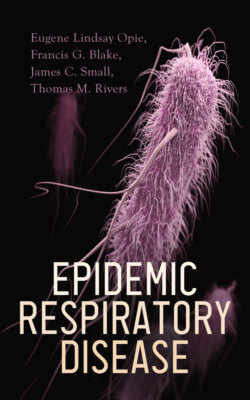Читать книгу Epidemic Respiratory Disease - Thomas M. Rivers - Страница 25
Secondary Contact Infection in Influenza
ОглавлениеThe material so far presented has dealt with contact infection in cases of pneumonia following influenza. That a similar contact infection in cases of influenza treated in crowded hospital wards is responsible in considerable degree for the development of pneumonia in cases of influenza seems quite probable. It has already been stated that this pneumonia was found in large part to be caused by infection with types of pneumococcus that are found in the mouths of normal individuals. It has been fairly definitely established by Stillman52 that lobar pneumonia caused by pneumococcus Types I and II is in all probability due to contact infection, and definite instances of such infection by Pneumococcus Type II have been reported above. In a recent communication Stillman53 has furthermore shown that of the various groups of Pneumococcus II atypical those most frequently associated with pneumonia are rarely found in normal mouths, while those infrequently associated with pneumonia are more commonly found. Whether similar considerations will hold true for pneumococci of Group IV can only be determined by further investigation. It has been stated that certain observations made during the course of this work have suggested that cases of pneumonia which complicate influenza may be due to contact rather than to autogenous infection. The data available are far too limited to establish this fact and it would require a very extensive study to furnish conclusive evidence.
Certain general observations have suggested this point of view. It is well recognized that the incidence of pneumonia in patients with influenza has been much higher where overcrowding has existed. It would seem probable that this has been in large part due to the greater opportunity for the dissemination of organisms capable of producing pneumonia and the consequently increased opportunity for secondary contact infection among patients treated under such conditions. The not infrequent occurrence of influenzal pneumonia due to combined infections of the different types of pneumococci, hemolytic streptococci, staphylococci, and other bacteria, instances of which have been cited, is in harmony with this view, especially since pneumonia under ordinary conditions is rarely found to be associated with mixed infections of this nature. It is true that healthy individuals occasionally carry more than one type of pneumococcus simultaneously in the mouth, though this is very infrequent, and autogenous infection occurring in such individuals might account in some instances for the mixed pneumococcus infections encountered. By way of analogy it has been clearly shown in other studies by the Commission on the relation of hemolytic streptococcus carriers to the complications of measles, that secondary infection of the respiratory tract with S. hemolyticus is in very large part due to contact infection, the chronic carrier rarely developing complications due to this organism.
To obtain further light on this question the type of pneumococcus present in the mouths of 46 consecutive cases of early uncomplicated influenza was determined by the mouse inoculation method at time of admission to the receiving ward of the hospital before the patients had been associated, with the purpose of determining if cases among this group which subsequently developed pneumonia might be shown to have acquired a pneumococcus which they did not carry at time of admission. This group of patients was treated in a special ward set apart for the purpose. The patients were assigned to beds in rotation and confined in bed until thoroughly convalescent. Beds were well separated and cubicles, masks and gowns were in use. Cultures were made from the ward personnel. By these procedures an accurate record was kept of all sources of pneumococcus infection. The types of pneumococcus found in the mouths of these patients at time of admission are shown in Table XXV.
| Table XXV | ||
|---|---|---|
| Types of Pneumococci in the Mouths of Influenza Patients | ||
| PNEUMOCOCCUS | NUMBER | PER CENT |
| Pneumococcus, Type I | 0 | 0 |
| Pneumococcus, Type II | 0 | 0 |
| Pneumococcus, II atypical | 1 | 2.2 |
| Pneumococcus, Type III | 0 | 0 |
| Pneumococcus, Group IV | 25 | 54.3 |
| No pneumococci found | 20 | 43.5 |
Only 1 patient in this group developed pneumonia. At time of admission he had no pneumococcus in his mouth as determined by inoculation of a white mouse with his sputum. Examination of the sputum by the same method at time of onset of pneumonia three days after admission showed Pneumococcus Type III. The only ascertainable source of infection in this case was one of the ward attendants who carried Pneumococcus Type III in his throat in sufficiently large numbers to be demonstrable by direct culture and who frequently came in contact with the patient. In this instance the development of pneumonia was probably due to contact infection. An extensive study of this nature would be necessary to determine in what proportion of cases pneumonia following influenza is caused by secondary contact infection and in what proportion to autogenous infection. It is at least evident that contact infection with a type of pneumococcus found in the mouth of normal individuals may occur in influenza and be responsible for the development of pneumonia. Therefore every precaution should be taken to prevent it.
